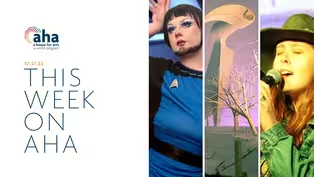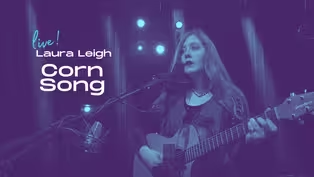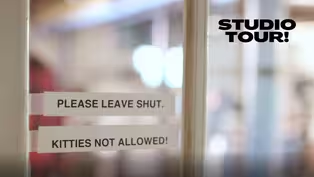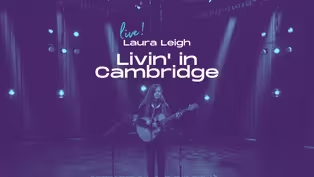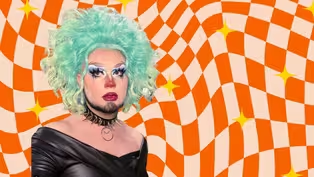
AHA! | 815
Season 8 Episode 15 | 27m 45sVideo has Closed Captions
Explore the artistic process of Kenneth Ragsdale, valuable drag advice from Typhoid Mary.
Experience the unique art of Kenneth Ragsdale as he transforms objects from his past into landscapes through drawing, sculpture, photography & painting. Get to know Typhoid Mary, a prominent figure in the Albany NY drag scene, as they share their journey and give advice to aspiring drag artists. Don't miss Laura Leigh's performance of the title track from her 2021 debut album, Livin' in Cambridge.
Problems playing video? | Closed Captioning Feedback
Problems playing video? | Closed Captioning Feedback
AHA! A House for Arts is a local public television program presented by WMHT
Support provided by M&T Bank, the Leo Cox Beach Philanthropic Foundation, and is also provided by contributors to the WMHT Venture Fund including Chet and Karen Opalka, Robert & Doris...

AHA! | 815
Season 8 Episode 15 | 27m 45sVideo has Closed Captions
Experience the unique art of Kenneth Ragsdale as he transforms objects from his past into landscapes through drawing, sculpture, photography & painting. Get to know Typhoid Mary, a prominent figure in the Albany NY drag scene, as they share their journey and give advice to aspiring drag artists. Don't miss Laura Leigh's performance of the title track from her 2021 debut album, Livin' in Cambridge.
Problems playing video? | Closed Captioning Feedback
How to Watch AHA! A House for Arts
AHA! A House for Arts is available to stream on pbs.org and the free PBS App, available on iPhone, Apple TV, Android TV, Android smartphones, Amazon Fire TV, Amazon Fire Tablet, Roku, Samsung Smart TV, and Vizio.
Providing Support for PBS.org
Learn Moreabout PBS online sponsorship(gentle music) - [Jade] Create artwork from memory with Ken Ragsdale.
Spill the tea with drag queen, Typhoid Mary.
And catch a performance from Laura Leigh.
It's all ahead on this episode of AHA, A House for Arts.
(gentle music) - (Announcer) Funding for AHA has been provided by your contribution and by contributions to the WMHT venture fund.
Contributors include The Leo Cox Beach Philanthropic Foundation, Chet and Karen Opalka, Robert and Doris Fischer Malesardi and The Robison Family Foundation.
- At M&T Bank we understand that the vitality of our community is crucial to our continued success.
That is why we take an active role in our community.
M&T is pleased to support WMHT programming that highlights the arts, and we invite you to do the same.
(gentle music) - Hi, I'm Jade Warrick, and this is AHA, A House for Art, a place for all things creative.
Here's Matt with today's field segment.
(soft music) - We're in Albany, New York taking a look at the fascinating process behind the work of artist Ken Ragsdale.
Let's go.
(gentle music) (door opens) (door closes) - I make two dimensional images that start out as drawings and then they become sculptures, and then they become photographs, and then they become paintings.
I really wanted to make painted landscapes.
That's, I always painted landscapes and that's what I wanted.
And then it became apparent that there were a lot of people making painting lands, painted landscapes.
So I thought, well, there's something, there's gotta be something that I know how to do that nobody else knows how to do.
How can I use that?
(gentle music) When I was a kid, I would do schematic drawings for my Dad who was a hydraulics engineer and he had a shop and people would call him and they'd, and he would be on the phone with this long stick with a piece of chalk on it, and in the shop he would be making these sort of hieroglyphics on the floor while he talked on the phone.
And he was figuring out how much power and how much, you know, length of hose and what the pump needed to be in order to run these projects.
And when he was done, it was my job to look at the chicken scratches and make a schematic drawing that people could understand.
(gentle music) So over the years, this idea of thinking and idea through a schematic started to become even more three-dimensional.
I started to think of everything as living in a box, and how could I take that box and open it up onto a flat sheet.
(soft music) When I was in grad school, I started taking these drawings, these sketches, and building little models and then setting them up and painting them.
And they said, "Well, you know, that's still not very interesting."
And they said, "Why don't you photograph them?"
(gentle music) Ultimately, what I realized is that I could make a painting with light.
It was still a two-dimensional image, it was still a landscape, it's still with color, but it was just light on paper.
The first one that comes to mind is one that I did in grad school, and it was the first time that I sort of saw the potential, and it's called, "Night".
And it's a scene of the house that my Dad built that we lived in.
It had a lot of blues, dark blues and things.
And I wanted a light in the house, but I didn't, I was so, I didn't understand it well enough at the time.
So I thought, oh what I'll do is that I'll just cut a hole underneath the table and I'll put a flashlight in there.
And it was beautiful, it was fantastic.
It was like, it was exactly the right color.
(laughs) So just to get this little glow in the window.
And yeah, so that one sort of set really the scene for everything that I did after.
(ominous music) The images that I make are all from memory.
I take things that I'm familiar with from my past and I sort of reconfigure them into a new landscape.
The memory is really about a moment of anticipation.
I want, when people look at the image to think that something may have just happened or that it was about to happen, but it was in that, that moment where you weren't sure which direction things were going in.
And I never have people, there's never any figures in any of them because I think figures are too specific.
I think there's something about this specificity of a viewer trying to understand what a figure in a landscape is doing, that it takes away from that possibility of things may be happening in this direction or that direction.
(suspenseful music) All of the objects, the players, I guess I would call them the cars, the houses, the trees, whatever.
A long time ago I made a really stupid rule for myself that each one of those objects had to be made outta one piece of paper and I couldn't use tape or glue.
That it had to be held together just with tabs and slots.
(gentle music) Part of that came from the idea that everything was because it was all about my memory and your memory is always in flux and it's always sort of transferable and never fixed.
So I wanted everything that I made to be able to come apart in life flat again, and that I could store it away, I could bring it back, I could reattach it, I could change it, I could do whatever.
So it was never fixed.
(gentle music) A car is a perfect opportunity.
So knowing that everything fits in a box, you think, okay if I have to open up that box What's the best center point for that to functionally operate?
And in the case of a car, it would be the roof, that's easy.
So I can start, I will just start, when I draw I'll just start in the middle and I'll start making straight, lots of straight lines.
And the weird thing is, is that I don't really have a plan when I start.
I kind of have a plan, but it's in the process of drawing all of these straight lines that it starts to, I can start to feel my way into it.
I can start to see dimension and if this is this wide then it needs to be this wide.
And then I'll start to allow that thing, so the sides will come out, the front, the windshield will attach to a hood, to the grill and then things might come in underneath of it and it's like, how do I attach the bottom?
I have a whole system for wheels, which are then attached you know, by a structure to the bottom of the car.
But almost anything can be built that way.
(gentle music) So I have thousands of these objects.
And so then I can pick and choose if I need to make a new one, I make a new one.
And then I have a digital camera set up and the camera's on a live feed to a video monitor.
And that way if I'm out in the scene trying to arrange things, I can look up at the monitor and go, oh yeah it needs to go that way a little bit and I can scooch it.
(soft music) The idea of working from memory that really appeals to me is that it's sort of, in a weird way, the only objective truth.
Your memory is sort of so in flux and so incapable of holding onto details, that clearly the details don't matter anymore.
It's only what you remember that matters.
(gentle music) The artist, William Kenridge, in one of my favorite quotes is he says that, "Making art is a way of arriving at knowledge that is not subject to cross examination."
And so what you're trying to do is to try to build an image a very layered, complex image that in and of itself is believable, but in its own way so that people when they come to it, they go, "Oh I get that, I understand that."
But it's not connected to any other believable reality that they know.
So they can't argue it.
(gentle music) - Typhoid Mary has been part of the Albany drag scene since 2019.
As a performer, host, stage manager, producer, graphic artist, and more, Typhoid and all the drag queens put in a lot of work into their craft.
So what is the Albany drag scene like?
And what advice does Typhoid have for other baby queens out there?
Let's find out.
Welcome to AHA Typhoid Mary, I'm excited to talk to you today.
- Thank you so much for having me, very excited to be here.
- I wanna know why the name Typhoid Mary?
Where did that, where did that drag name come from?
- When I was coming up with names, I wanted it to sort of not only reflect my culinary background, but my, like, nerdy background.
And, I wanted to make sure that I had a name that no one else had.
- It's true.
Explain your culinary background and your nerdy background a little bit.
- So I did go to culinary school.
My family owned a diner for years.
And, my nerdy background is my, like my immediate family owns a comic bookstore.
- Oh really?
- Yeah.
- Wanna give us what comic bookstore it is?
- Ah, Zombie Planet.
- Ah, Zombie Planet.
One of the local faves.
- Exactly.
- So I probably had a lot of influence on that.
(Mary laughs) That's so cool.
So what brought you into drag?
Like what made drag an attractive performance art for you?
- For me, it was more about creating this like persona and like, almost like this hyperextension of like, these personality traits that, I wouldn't really be all the time as like, Theo, like the artist.
So it sort of just became like, yeah, like a hyperextension of who I wanted to be.
- And who would you want to be?
Like what is, when you say hyperextension what are these traits entail?
Like what traits are you like really blowing up?
- Like you wouldn't, (laughs) you wouldn't believe it but I am an introvert, so, (laughs) creating this very like, extroverted, like, alternative very just like goth, grunge, angsty teenage girl.
(laughs) - I love that, you're like, that's a piece of me that needs to be released.
- Exactly!
- Yes!
(both laughing) So, what was your inspiration?
So you said a little bit of grunge, a little bit of like pop, but, what are your inspirations for your performances and your costumes?
- I do pull from a lot of like, or uh, late nineties, early two thousands, like alternative goth fashion.
That is definitely something that like I was like surrounded by a lot growing up and I just like always loved it but like never really was able to just like be that, by creating this like hyper, personified extension of myself, like this drag persona.
I was able to wear the things that I wanted to and sort of create the things that I wanted to.
- So, you're really able to express yourself in a way you wouldn't be able to outside of drag, it seems like.
- Oh, 100% yeah.
- And how does that feel?
- Um, it's very liberating, it's very freeing.
- I can only imagine like, how liberating.
- Yeah, it's sort of like, like taking like, there's like this little like box inside of you, like that you kept like, kept inside and just like, you're growing up and you're forgetting about the box and then, finally one day you're just like, "There's that box!"
- Yeah.
- Let me just open that wide open.
(laughs) - Just like, let it go loose.
- Just let it go loose.
- Let's have some fun.
- Yeah.
- Is there anyone in particular, like musician wise?
I know you said, um, I believe you said maybe something of influence within TV, but what are these TV shows and like, other like, what's some direct like, TV shows and things that, yes, I wanna hear some of those direct influences.
- I grew up watching a lot of, (laughs) um, "Buffy the Vampire Slayer," "Xena Warrior Princess," like- - Yes.
- Very strong female leads.
Always, always watching, always eating up like, they were like, the icons for me.
- Oh my God, it's beautiful.
And any like, comic books or anything like that or any music?
- Oh, music wise?
Um, (laughs) Evanescence, AVR Levine, - Classic.
- Classics, so just the classics.
Um, more like recently, Billie Eilish.
She is a big one for me.
Like, I love performing her and her songs are just absolutely, absolutely phenomenal.
- Is there any reason why Billie Eilish is a hit for you that's different?
- I think it definitely is the aesthetic and like the songs that she writes, like they're just, they really do speak to that little that angsty teenage girl.
(laughs) - Yeah, I mean, yeah, (both laughing) That's Billie Eilish all right so.
So I know you do a lot of events around the community a lot of drag events around the community.
I've been to several of those events, they're always packed.
There's always a lot of support for them and you just feel this life and this safe space and you just feel really comfortable in these spaces that you curate.
And I want to hear from your perspective, why do you think this is beneficial and valuable for the LGBTQ plus community and the drag community locally?
- So essentially, I started producing my own shows because I wanted to create that like you just said.
That fun and that safe environment because I had a, when I first started there weren't too many places that felt that way.
- Yes.
- It was very hard to not only one get into the drag scene, but then on top of it, be in a space where I felt like I was having fun at like the expense of like, my safety.
Or I was safe, but I wasn't having fun.
So I believe that the two of those mutually go hand in hand.
- That's true.
- So, as I started to get a little more seasoned with drag it became something that I wanted to do and I wanted to, make a space for my community.
And like you've said I feel like I've definitely accomplished that.
- You have, you really have.
And have you got any feedback from the community how they feel about this since your shows are really packed and really supported by the community, have you heard any type of feedback or anything or how folks feel?
- I always hear, that my shows are memorable.
- Yes, yes they are.
- And, not only are they memorable, but, I sort of shatter the expectations that people have going into a drag show.
- Which are?
- A lot of people's first exposure to drag is what you see on TV.
- Mm-hmm.
- And that is okay and that's fine and that's fun, but that's not always what drag is.
Like, look at this, this isn't maybe something you wouldn't see on TV.
I'm bearded, I'm a little more alternative.
So by having people's expectations sort of blown away by what I can offer by having not only a diverse group of drag performers, but just having a very fun show.
- Yeah.
- You know?
- And inclusiveness is important too.
- Oh, 100%.
- Because you do have performers that are very inclusive.
Like I haven't even seen drag performers like how I see at your shows on TV.
- Oh, yeah.
- You know, like it's a very inclusive- - Oh, yeah.
- Accepting, safe space.
- That's definitely what I'm aiming to do with my shows.
(laughs) - Yes.
So, what would you say would be the most fulfilling part about drag and the toughest parts?
- Oh, I would say some of the more like frustrating aspects of drag are, like with any creative field, is, dealing with other people's egos, definitely tends to be with one.
But, that is something that can be so nipped in the bud as soon as you just talk to someone, show a little kindness.
I guess for me personally, it's always challenging myself to sort of be better than the last time or sort of like, have, like feeling like I've grown since the last time I've gotten into face or the last time that I've performed.
So, those, that's my own personal frustration.
- And what about the most fulfilling part of it?
Like what makes you, what brings joy to you with this craft?
(Mary sighs) - My favorite part, especially as someone who is like a little more alternative and doesn't really perform everything you hear on the radio, is finding someone in the crowd who's connecting with you as you're performing.
And just like, it very much feels like in this moment it's just you and them.
Like, you're lip syncing and you're performing, and they're just like in absolute awe of what you're doing.
And you're just like, it's like this very special bond from like performer to like audience member.
And then to have them like, come up to you afterwards and be like, "That was amazing."
"I've never seen anyone perform that song!"
"It's my favorite song!"
Like, all this other stuff.
It tends to happen a lot when, (laughs) when Evanescence shows up.
- Always, I will say nineties kids, we love our Evanescence.
Even though we only know that one song.
- Oh exactly, exactly, they're like, "Oh My God, I would've never imagined seeing a drag artist perform bring me to life."
And I'm just like, "Gotcha."
- Thank you.
(Mary laughs) Well, that's amazing.
That's a very fulfilling way to enjoy your craft.
Do you have any advice for any folks who want to break into drag queening and kinging?
Like, just in the drag world in general?
- My advice is always to be kind.
Like, you can create this persona that's like, all like, full of attitude and cattiness and whatever, but at the end of the day, kindness will get you farther.
- Yes.
- And that is something that I've always held close to myself and to my persona, and it's always been a standard of just being nice to everyone 'cause also, you don't know what someone's going through.
- That's very true, that's very true.
Well, thank you Typhoid Mary, and thank you for talking to us today and in being on AHA.
We appreciate you.
- Thank You so much for having me, I appreciate it.
- Please welcome, Laura Leigh.
(soft guitar music) - It's a song I wrote about my hometown, Cambridge, New York.
(soft guitar music) ♪ Living in Cambridge ain't that bad ♪ ♪ Got the river and the trains are sad ♪ ♪ Got your old friends on a Saturday night ♪ ♪ Makes me feel that the world's all right ♪ ♪ You can get born here and you can die ♪ ♪ You can get low, you can get high ♪ ♪ You can get married and you can leave ♪ ♪ You can do just what you please ♪ ♪ Uh, uh, uh, uh, uh ♪ ♪ Uh, uh, uh, uh, uh, uh, uh ♪ (soft guitar music) ♪ You can float down the river in a big old tube ♪ ♪ Hit the round house for some food ♪ ♪ Down at the depot everybody knows your name ♪ ♪ Say you and your sister both look the same ♪ ♪ Living in Cambridge and it ain't that bad ♪ ♪ I got my brothers and my Mom and Dad ♪ ♪ They always wanted what was best for me ♪ ♪ Raise me right here in God's country ♪ ♪ Uh, uh, uh, uh, uh ♪ ♪ Uh, uh, uh, uh, uh, uh, uh ♪ ♪ Hey, go head down to the county fair ♪ ♪ Everybody takes their cows down there ♪ ♪ And it's nice to move back to your hometown ♪ ♪ Landy won't stop the sacred ground ♪ ♪ Go for a burn cruise down Ashgrove ♪ ♪ Drive real slow in the snow ♪ ♪ I've seen too many friends here come and go ♪ ♪ 'Cause this town can grow a shadow on your soul ♪ ♪ Everybody wants their own little piece of me ♪ ♪ At least the girl they expect me to be ♪ ♪ I think I'll get outta Cambridge before I grow old ♪ ♪ Before the streams dry up, the shops all close ♪ ♪ Before the heroes of my childhood all pass away ♪ ♪ And I'll never find out how to fly away ♪ ♪ Living in Cambridge ain't that bad ♪ ♪ Got the river, the trains are sad ♪ ♪ Got your old friends on a Saturday night ♪ ♪ Makes me feel that the world's all right ♪ ♪ Makes me feel that the world ♪ ♪ Is all right ♪ (soft guitar music) ♪ There is something in the field ♪ ♪ I saw it the other night ♪ ♪ It came running so fast ♪ ♪ And the moon was shining so bright ♪ ♪ It took everything that I love ♪ ♪ Vanished in the night ♪ ♪ Through the fields of yellow corn ♪ ♪ Vanished out of sight ♪ ♪ Vanished in the night ♪ ♪ Where did my love go ♪ ♪ It was stolen in the night ♪ ♪ Left me all alone ♪ ♪ Didn't even put up a fight ♪ ♪ And there's a sadness in that hill ♪ ♪ And the house on it just grows ♪ ♪ Out the door it won't keep still ♪ ♪ And the fields of hay are cut low ♪ ♪ Fields of hay are cut low ♪ ♪ People they never die ♪ ♪ They just ♪ ♪ Walk out into the corn ♪ ♪ And your spirit ♪ ♪ Stays alive ♪ ♪ In those fields where you were born ♪ ♪ Now their Sodom is the ghost ♪ ♪ Are you lost or are you dead ♪ ♪ Last my heart does know ♪ ♪ Lost all it ever wanted ♪ ♪ And the old timers have passed through ♪ ♪ But the tire tracks remain ♪ ♪ In a dream all soft and blue ♪ ♪ Saw you by the river in the rain ♪ ♪ In the river in the rain ♪ ♪ People, they never die ♪ ♪ They just ♪ ♪ Walk out into the corn ♪ ♪ And your spirit ♪ ♪ It stays alive ♪ ♪ In those fields where you were born ♪ ♪ In those fields where you once were born ♪ ♪ In those fields where you were born ♪ (gentle music) - Thanks for joining us.
For more arts, visit wmht.org/aha and be sure to connect with us on social.
I'm Jade Warrick and thank you for watching.
(gentle music) - (Announcer) Funding for AHA has been provided by your contribution and by contributions to the WMHT Venture Fund.
Contributors include the Leo Cox Beach Philanthropic Foundation, Chet and Karen Opalka, Robert and Doris Fisher Malesardi and The Robison Family Foundation.
- At M&T Bank, we understand that the vitality of our communities is crucial to our continued success.
That's why we take an active role in our community.
M&T Bank is pleased to support WMHT programming, that highlights the arts and we invite you to do the same.
Video has Closed Captions
Preview: S8 Ep15 | 30s | Explore the artistic process of Kenneth Ragsdale, valuable drag advice from Typhoid Mary. (30s)
Experience the Soulful Sounds of Laura Leigh's 'Corn Song'
Video has Closed Captions
Clip: S8 Ep15 | 3m 20s | Don't miss a special live performance by Laura Leigh singing 'Corn Song'. (3m 20s)
Exploring the Creative Mind of Kenneth Ragsdale: Studio Tour
Video has Closed Captions
Clip: S8 Ep15 | 7m 38s | Explore Kenneth Ragsdale's unique blend of drawing, sculpture, photography, and painting. (7m 38s)
Laura Leigh Performs 'Livin' in Cambridge'
Video has Closed Captions
Clip: S8 Ep15 | 3m 26s | Laura Leigh performs the title track from her 2021 debut album, 'Livin' in Cambridge'. (3m 26s)
Meet Typhoid Mary: A Multifaceted Drag Artist from Albany NY
Video has Closed Captions
Clip: S8 Ep15 | 10m 6s | Typhoid Mary discusses their journey in drag and offers advice for aspiring artists. (10m 6s)
Providing Support for PBS.org
Learn Moreabout PBS online sponsorship

- Arts and Music

Innovative musicians from every genre perform live in the longest-running music series.












Support for PBS provided by:
AHA! A House for Arts is a local public television program presented by WMHT
Support provided by M&T Bank, the Leo Cox Beach Philanthropic Foundation, and is also provided by contributors to the WMHT Venture Fund including Chet and Karen Opalka, Robert & Doris...
